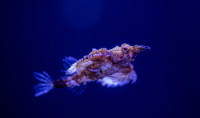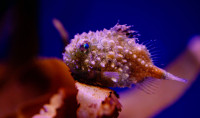Do you ever wonder where scientific names come from? The process of naming different organisms is called taxonomy, which is a complex process made up of many rules so that each name is unique to the creature it describes. Many scientific names traditionally use Latin and Greek roots, so it is common to find names that are connected to Greek Mythology. Here are some sea creatures at Birch Aquarium with ties to stories from the ancient world.

Dragon Sea Moth: Eurypegasus draconis
With fins like majestic wings and a horse-like snout, it’s no surprise that the Dragon Sea Moth’s scientific name, Eurypegasus draconis, is inspired by the myth of Pegasus. In Greek mythology, Pegasus is a magical winged horse that sprang from the head of Medusa when she was beheaded by the hero Perseus. While the Dragon Sea Moth may not be magical, it does have the ability to shed its skin and camouflage into its surroundings. You can find our Dragon Sea Moth soaring through the water in Seadragons & Seahorses!

Long-snout Seahorse: Hippocampus reidi
According to Greek mythology, the Hippocampus is a creature with the head and limbs of a horse and the lower body of a fish. Thanks to its distinctive horse-like head and long body, the scientific Genus for seahorse, Hippocampus, makes perfect sense. The elegant Hippocampus is famous for leading Poseidon’s chariot and Long-snout Seahorses are just as elegant, even if smaller in size. The similarities between the two are strong, however Hippocampi lack the prehensile tails that Longsnout Seahorses use to hold onto aquatic plants or other things they can anchor to in their environment. Check out our Long-snout Seahorses in Seadragons & Seahorses!

Pacific Spiny Lumpsucker: Cyclopteridae Eumicrotremus orbis
The scientific family for the Pacific Spiny Lumpsucker is Cyclopteridae, which may remind you of the famous mythological Cyclops! In fact, the “clops” in both of these stems from the Greek words kyklops and kyklos, meaning circular and round. The Pacific Spiny Lumpsucker is known for its distinctive round shape and suction cup on its underside, formed from its pectoral fins. While lumpsuckers may not have one round, central eye like a Cyclops, they do have very distinctive and prominent round eyes on their equally round bodies. Visit our Pacific Spiny Lumpsuckers in the Hall of Fishes!

Shrimpfish: Aeoliscus strigatus
The scientific name for Shrimpfish is Aeoliscus strigatus which comes from the Greek God of wind, Aeolus. In Greek mythology, Aeolus lives on the island Aeolia, and is most famous for gifting a bag of wind to the legendary hero Odysseus in order to help him sail home to Ithaca. The unique morphology of Shrimpfish allows them to gracefully move through the ocean currents, appearing as if being swept away by the wind themselves. This form is not just an aesthetic marvel, but it allows Shrimpfish to be agile and better camouflage to hide from predators. Shrimpfish can also be found in Seadragons & Seahorses.